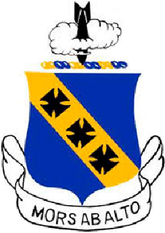| 7th Operations Group | |
|---|---|
 A 7th Operations Group B-1B Lancer releases a Joint Air-to-Surface Standoff Missile over the White Sands Missile Range, NM | |
| Active | 6 September 1918 – present (105 years, 2 months) Detailed
|
| Country | |
| Branch | |
| Part of | |
| Garrison/HQ | Dyess Air Force Base, Texas. |
| Motto(s) | Mors Ab Alto Latin Death from Above |
| Engagements | World War I
|
| Decorations | Distinguished Unit Citation Air Force Outstanding Unit Award |
| Insignia | |
| 7th Operations Group emblem[note 1] |  |
| 7th Bombardment Group emblem (approved 30 January 1933)[2] |  |
| Tail Code | DY |
| Aircraft flown | |
| Bomber | B-1B Lancer |
The 7th Operations Group is the operational flying component of the United States Air Force 7th Bomb Wing, stationed at Dyess Air Force Base, Texas. The 7th Operations Group currently flies the B-1 Lancer.
The 7th Operations Group is a direct successor organization of the 7th Bombardment Group, one of the 15 original combat air groups formed by the United States Army before World War II.
Activated in 1921, it inherited the lineage of the 1st Army Observation Group, which was established and organized, on 6 September 1918. The 7th Bombardment Group was deploying to the Philippines when the Imperial Japanese Navy Air Service attacked Pearl Harbor on 7 December 1941. Six of the group's B-17 Flying Fortress aircraft which had left Hamilton Field, California on 6 December 1941 reached Hawaii during the enemy attack, but were able to land safely. The unit later served in India during World War II.
In the postwar era, the 7d Bombardment Group was one of the first USAAF units assigned to the Strategic Air Command on 1 October 1946, prior to the establishment of the United States Air Force. Equipped with low-hour B-29 Superfortress surplus World War II aircraft, the group was inactivated in 1952 when the parent wing adopted the Tri-Deputate organization and assigned all of the group's squadrons directly to the wing.
Reactivated as the 7th Operations Group in 1991 when the 7th Bomb Wing adopted the USAF Objective organization plan.
- ^ a b Haulman, Daniel L. (27 June 2017). "Factsheet 7 operations Group (ACC)". Air Force Historical Research Agency. Retrieved 8 June 2020.
- ^ Maurer, pp. 43-45
Cite error: There are <ref group=note> tags on this page, but the references will not show without a {{reflist|group=note}} template (see the help page).
